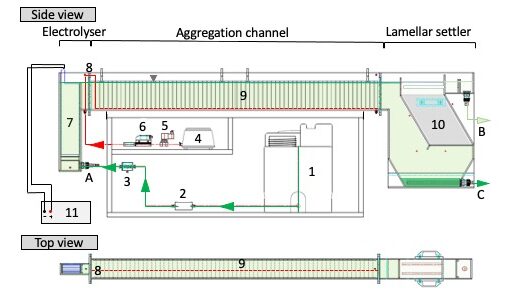Continuous electrocoagulation of Chlorella vulgaris in a novel channel-flow reactor: A pilot-scale harvesting study
Chlorella is a genus of unicellular microscopic algae often used in the food and feed industry and nowadays it is commonly available in retail stores. Although the productivity of chlorella is several orders of magnitude higher than that of agricultural crops, its biomass is still significantly more expensive than food produced by traditional agriculture. One reason for this is the costly separation of the biomass from the cultivation medium. Chlorella cells are coccal with a diameter of about 10 µm, so they form a stable colloidal suspension in the culture medium and low-cost separation methods such as sedimentation or filtration cannot be effectively used to separate them. The most commonly used method is energy-intensive centrifugation.
Recently published research led by Dr. Brányiková from the Department of Multiphase Reactors in the international journal Bioresource Technology follows up on the 2020 paper “Electrocoagulation reduces harvesting costs for microalgae“, in which it was shown that electrocoagulation can be used as a suitable pre-treatment prior to centrifugation and its use leads to a significant reduction in centrifuged volume and thus energy costs. In the current follow-up paper, the design and testing of an innovative flow-through electrocoagulation unit with a working volume of 160 liters was described; the design of which was based on the knowledge gained during the previous parametric study of the process at a laboratory scale. The constructed flow-through reactor consists of three functional parts – (i) electrolyzer, (ii) aggregation channel, (iii) lamellar settler – in which (i) electrolytic dissolution of the iron anode (coagulant dosing), (ii) formation of cell aggregates during the flow of the cell suspension through an aerated channel with vertical perforated baffles, and (iii) sedimentation of the aggregates in the lamellar settling tank occur. It has been verified that high separation efficiency (>85%), low iron contamination of the harvested biomass (<4 mg/g dry biomass – thus the harvested biomass complies with the legislative requirements for food), and energy savings of more than 80% compared to harvesting by centrifugation alone can be achieved in this device.

Scheme of the channel flow reactor: A – inlet (microalgal suspension), B – outlet (cultivation medium), C – outlet (separated biomass), 1 – storage tank for microalgal suspension, 2 – pump, 3 – flow meter, 4 – air pump, 5 – solenoid valve, 6 – compressed air meter, 7 – electrodes (7 pcs), 8 – perforated aeration tube, 9 – submerged perforated plates (66 pcs), 10 – sloped plastic tubes (96 pcs), 11 – DC power supply.
- Lucáková S., Brányiková I., Kováčiková S., Masojídek J., Ranglová K., Brányik T., Růžička M.: Continuous electrocoagulation of Chlorella vulgaris in a novel channel-flow reactor: A pilot-scale harvesting study. Bioresource Technology 2022, 351, 126996. ISSN 0960-8524. E-ISSN 1873-2976. Dostupné z: doi: 10.1016/j.biortech.2022.126996